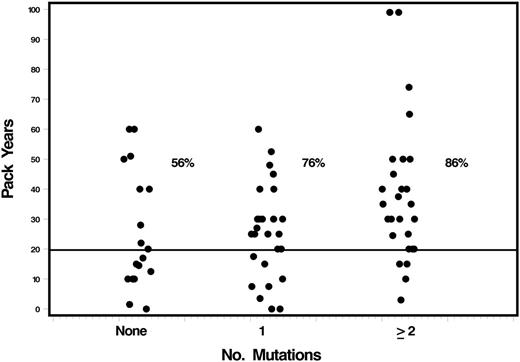Abstract
Smoking is a risk factor for development of MDS and for overall survival. The pathogenesis of MDS is a multi-step process with both environmental and genetic influences. The link between smoking and MDS is thought to be mediated by organic solvents in tobacco. We identified specific molecular abnormalities associated with smoking exposure in MDS patients (pts).
151 MDS pts seen from 2000-2012 with complete smoking and molecular data were included. Correlations and univariable comparisons were performed using Fisher’s Exact, Chi-square, Kruskal-Wallis, or Wilcoxon rank sum tests. Poisson regression models were used to assess associations between the number of mutations present and demographic and clinical factors. Analysis was performed using next-generation targeted deep gene sequencing with 22 common gene mutations, selected based on the frequency observed in a cohort of MDS patients analyzed by whole exome sequencing. Mutations were considered individually and in functional groups: methylation (TET2, IDH1, IDH2), histone modification (ASXL1, EZH2), and gene splicing (SRSF2, U2AF1, SF3B1). Paired DNA (tumor vs. CD3+ lymphocytes) produced raw sequence reads aligned using Burrows-Wheeler Aligner (BWA). Variants were detected using the Broad Institute's Best Practice Variant Detection GATK toolkit.
Median age at MDS diagnosis was 68 years (range 20-85); 42% were female; and 77% had de novo MDS. IPSS (low, Int-1, Int-2, high) and IPSS-R (very low, low, int, high, very high) categories were: 26%, 44%, 22%, 7% and 10%, 40%, 19%, 18%, 13%, respectively; IPSS-R cytogenetic categories were: very good (<1%), good (60%), int (14%), poor (12%), very poor (14%). Median survival was 42.6 months (95% C.I. 34.5-56.0). 54% of pts (81) were former (42%) or current (11%) smokers; median tobacco exposure was similar for both groups: 26 pack years (range 1.5-150) for former and 30 (10-60) for current smokers, p=0.22. More men than women ever smoked (p=0.03); all other clinical characteristics among never, ex-, and current smokers were similar. Overall 68% of pts (100) had at least one mutation of the 22 screened mutations: 32% (48) had a single mutation, 22% (33) had 2, and 13% (19) had 3 (n=10) to 6 (n=1) mutations. The most common mutations were in TET2 (19%), SF3B1 (15%), ASXL1 (14%), DNMT3A (11%), and U2AF1 (10%); 32% of pts had one or more mutation in genes involved in methylation, 19% in histone modification, and 32% with splicing. In univariable analyses, current/ex-smokers were more likely to have at least one of the common mutation than never smokers (75% vs. 52%, respectively, p=0.05). This was particularly true for genes involved in histone modification (25% vs. 11%, respectively, p=0.06). The number of mutations increased with smoking exposure (p=0.02, Figure 1), particularly with genes involved with histone modification, p=0.01. Certain mutations increased in prevalence with age, e.g.: pts<60 had fewer mutations overall than pts >60 (p=0.003), and in particular fewer mutations in methylation-associated genes (p=0.0001). In multivariable analysis that adjusted for IPSS-R cytogenetics, older age (p=0.0005) and greater smoking history/exposure (p=0.002) were both associated with more mutations. Current and ex-smokers and heavier smoking exposure (>20 pack years) were also associated with worse survival (p=.03 and .01, respectively), though current or ex-smokers with <20 pack years had similar survival to never smokers. Multivariable analyses confirmed smoking as a risk factor for survival (HR 1.63 (1.1-2.42); p=0.02).
Smoking Exposure (in Pack Years) and Number of Mutations Present. The percentages above the reference line are the proportions of patients in each group with >20 smoking pack years.
Smoking Exposure (in Pack Years) and Number of Mutations Present. The percentages above the reference line are the proportions of patients in each group with >20 smoking pack years.
Smoking is associated with a greater number of molecular abnormalities in MDS pts, and may generate a distinct mutational signature pattern, particularly along histone acetylation pathways. This study identifies specific environmentally-mediated pathways in the multistep pathogenesis of MDS.
No relevant conflicts of interest to declare.
Author notes
Asterisk with author names denotes non-ASH members.


This feature is available to Subscribers Only
Sign In or Create an Account Close Modal